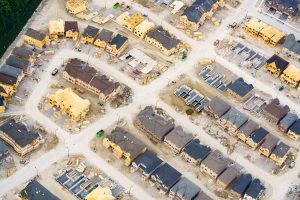There are drones for package delivery; drones for search and rescue; drones for surveillance; drones for photography. Now, another application has emerged, and continues to take steps getting it closer to reality: construction drones.
 For as long as planet Earth has been inhabited, construction projects have existed. Though it may have been primitive, there were many different projects being erected. From rope bridges, to the intricacies of the pyramids, right up to the luxury high-rises and the homes we see today, construction continues.
For as long as planet Earth has been inhabited, construction projects have existed. Though it may have been primitive, there were many different projects being erected. From rope bridges, to the intricacies of the pyramids, right up to the luxury high-rises and the homes we see today, construction continues.
The presence of drones in construction leads the way to many significant changes within the industry. They’ve already begun to change the landscape of how the industry operates, and those changes will have lasting effects.
Planning:
Every construction project begins with planning. They are complicated, time-consuming and resource-intensive projects. Using a drone for surveying purposes gives you a ‘birds eye view’ of the site that has been chosen for the project. This first step of using drones could help reduce cost, and give you the ability to see things that perhaps would not have been noticed from the ground.
In fact, many advanced construction projects are already transformed with drones. It’s only a matter of time before they become mainstream technology on most construction projects.
Now designed with the option to read geothermal levels, have longer battery life, and extremely high-resolution cameras, drones are more sought-after in the construction arena than ever before.
Communication and management:
The on-board technology of a drone has evolved to the point where instant connectivity and communication on the job site is at a surplus. They are being used in more ways to allow for better communication, and to be in constant contact between project managers who may be off-site, and those who are on-site. Many drones feature mounted cameras that can provide video footage to allow real-time viewing of any situation.
Analyzing the data:
Models that are equipped with browser-based technology allows clients to receive a link, log in, view the data, and export the information to anyone involved in the project. 3D models allow the client to get an orbital view of the entire site, see how the work is progressing, and report any changes that needs to be made.
Accurate security and surveillance:
Construction sites are not safe sites. Employing the use of drones can more accurately monitor any security breaches, and continually survey the area to ensure that there are no intruders.
They can also safely survey dangerous locations, reducing workplace accidents and increasing job site safety.
Inspecting structures:
Instead of using heavy software, and relying on complex readings, using a drone offers a first-hand view of how solid the structure is and in what phase the project is, all within a few minutes time.
Keeping the budget on-track, and on-budget:
By identifying the parts of the project that are going off-track, having the ability to prevent any causalities, rigorously monitoring your job sites, you will be much better prepared to remove any additions to project time and cost.
As many project managers know, real-time control is some of the most difficult to keep a handle on. The more information you have at your fingertips, the more control you have over your project ultimately. If something goes wrong on the site, you will lose drastically less money if you can correct the problem very quickly.
Many project managers are surprised at the ease of use and learning curve once they get started, and many seek to outsource the drone flying to someone else; either way, the boosted productivity is noticeable instantly.
None of this would be possible without 100% accuracy and reliability of the videos and images that the drones for construction relay back to those involved in the project. Universe Optics employs teams of engineers, along with their manufacturing facilities, to ensure that the precision lens in your construction drones offer the accuracy you demand.
Industrial robots have been explored for building structures for at least a decade; but there is a limit to the size of the project on which they can work. Since drones don’t have the constraints of other robots being studied for building, research using full-scale structures is more feasible, and it is certain that there will be more drones for construction projects in the near future.